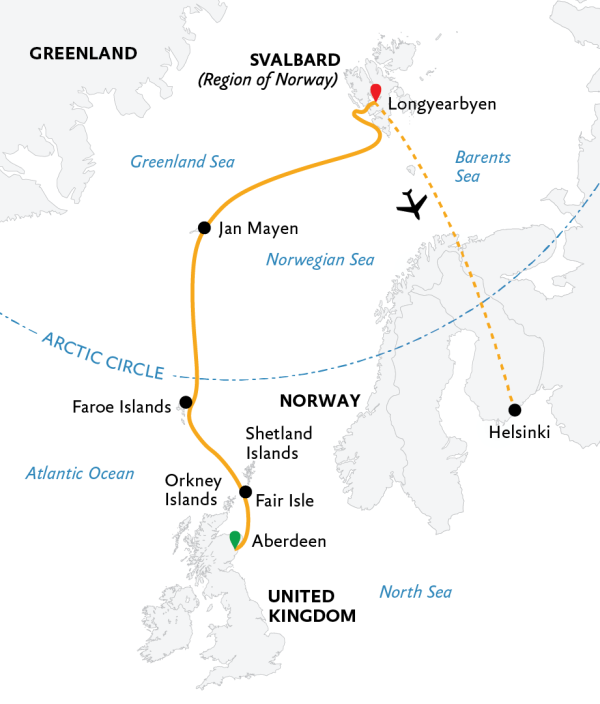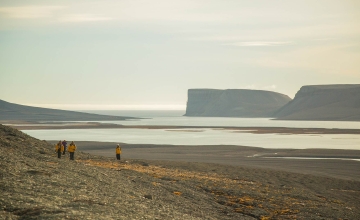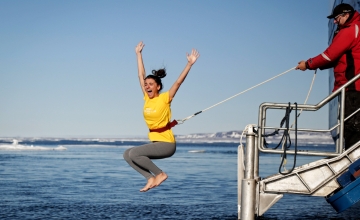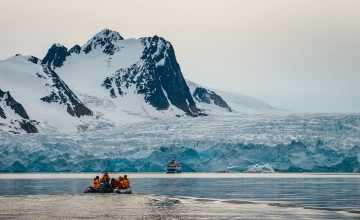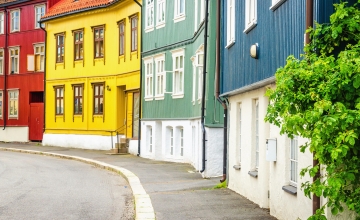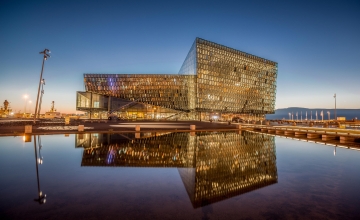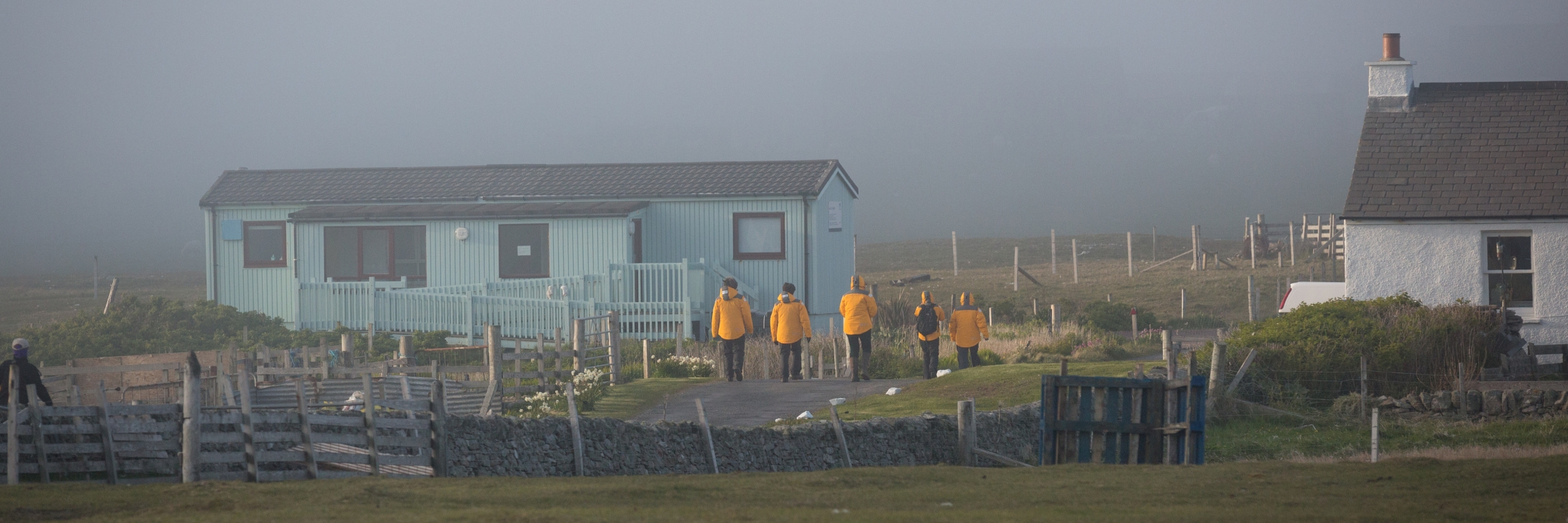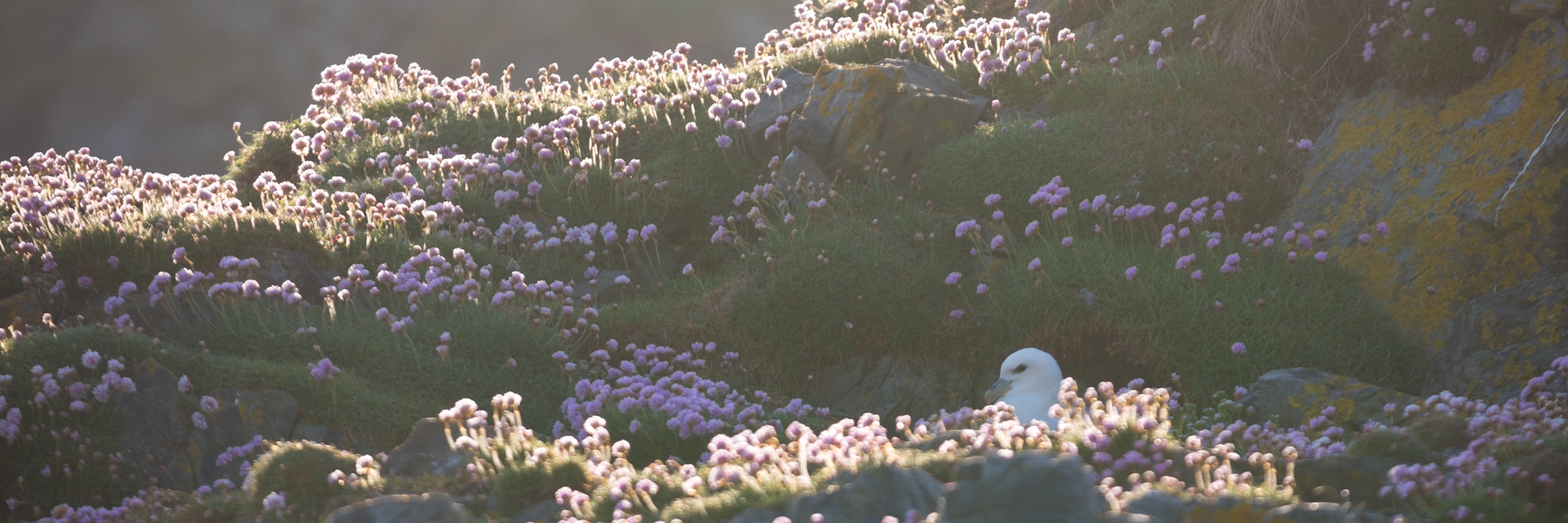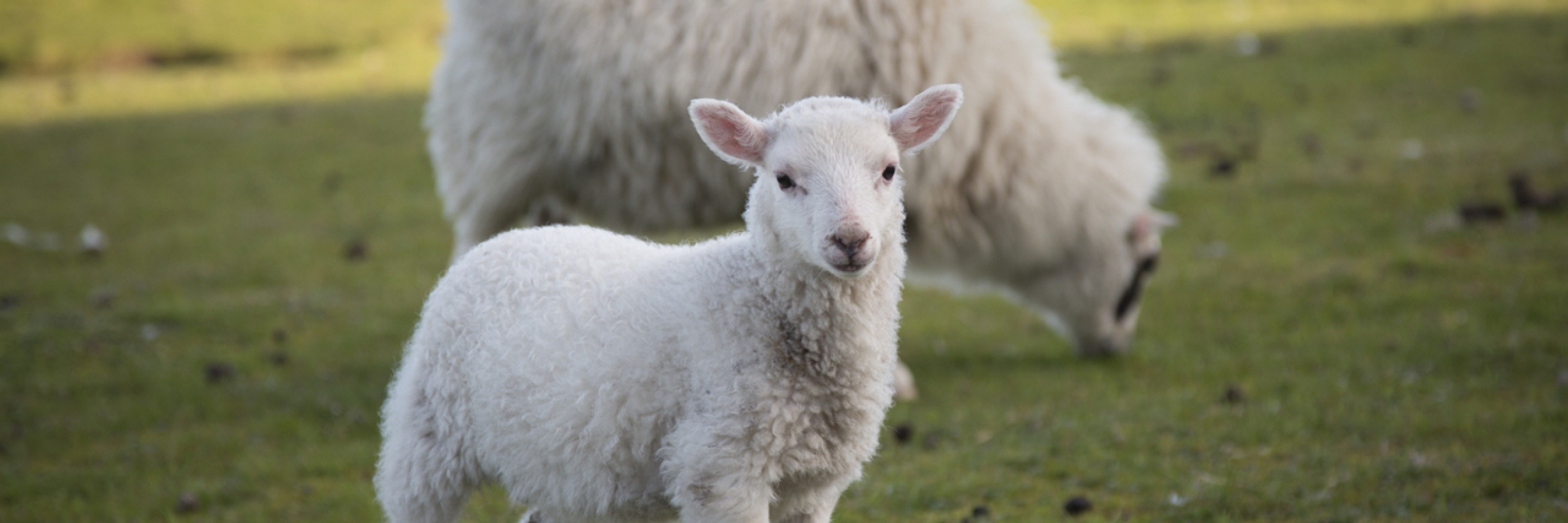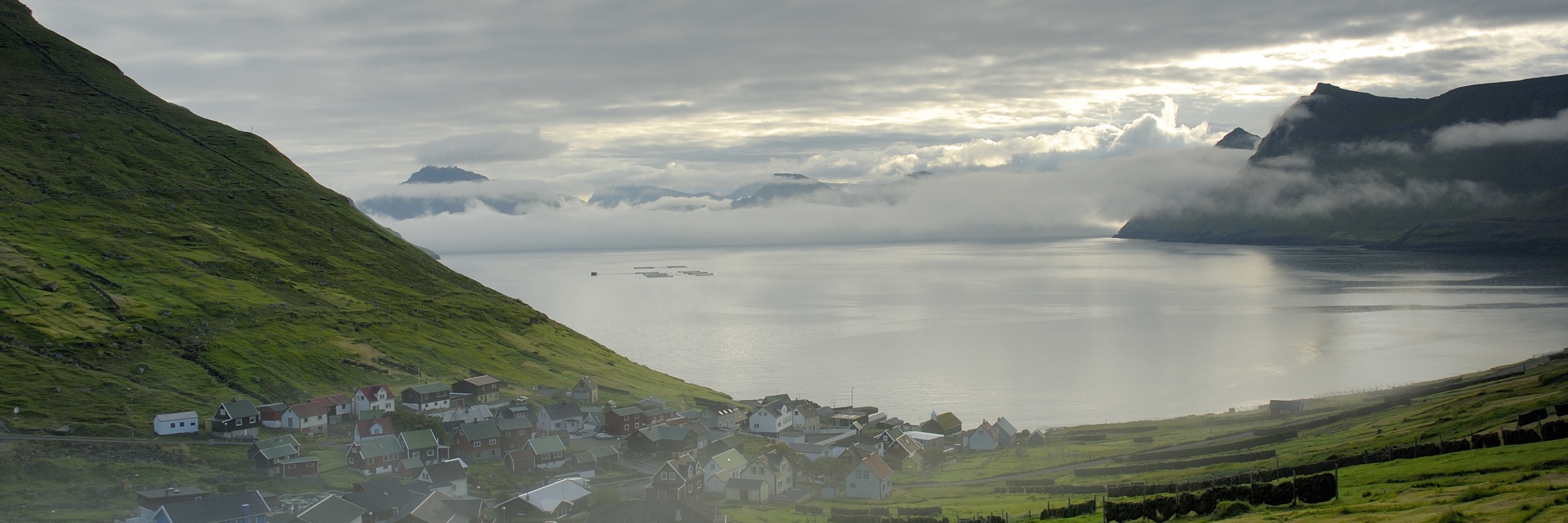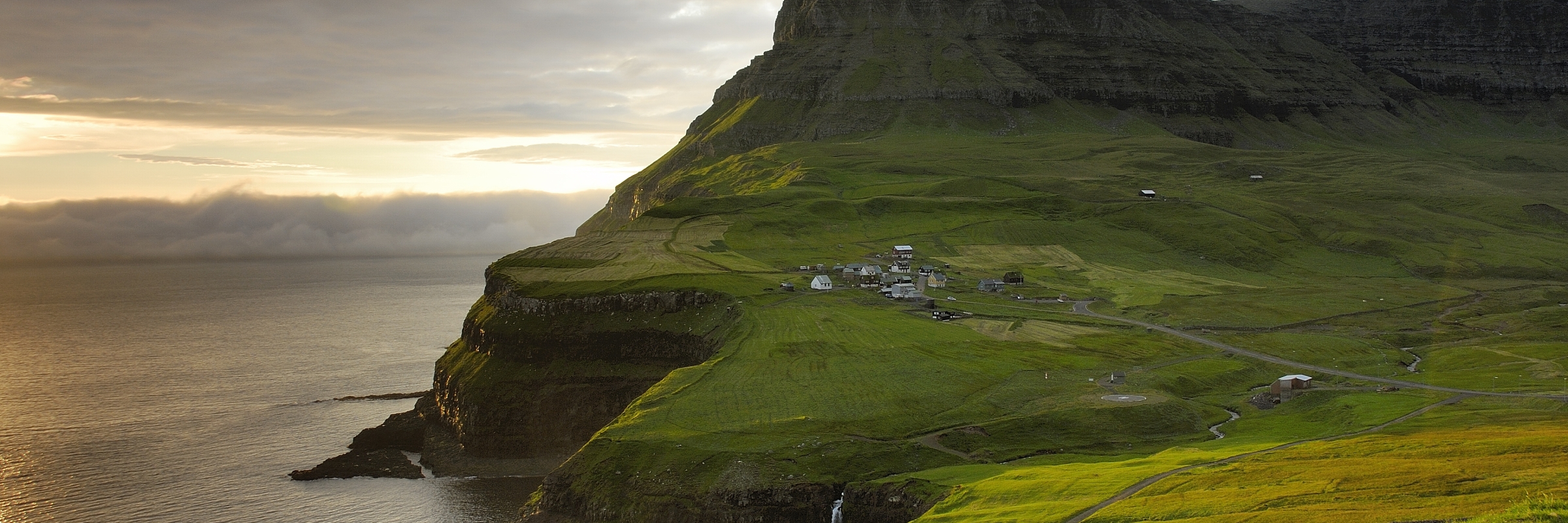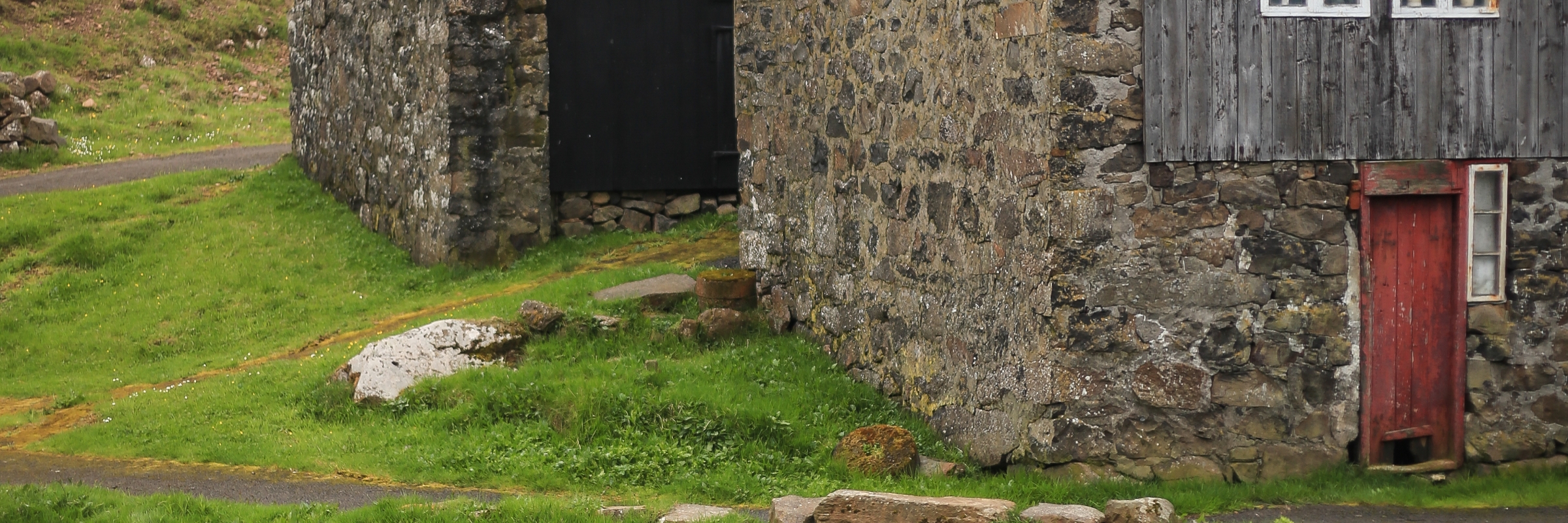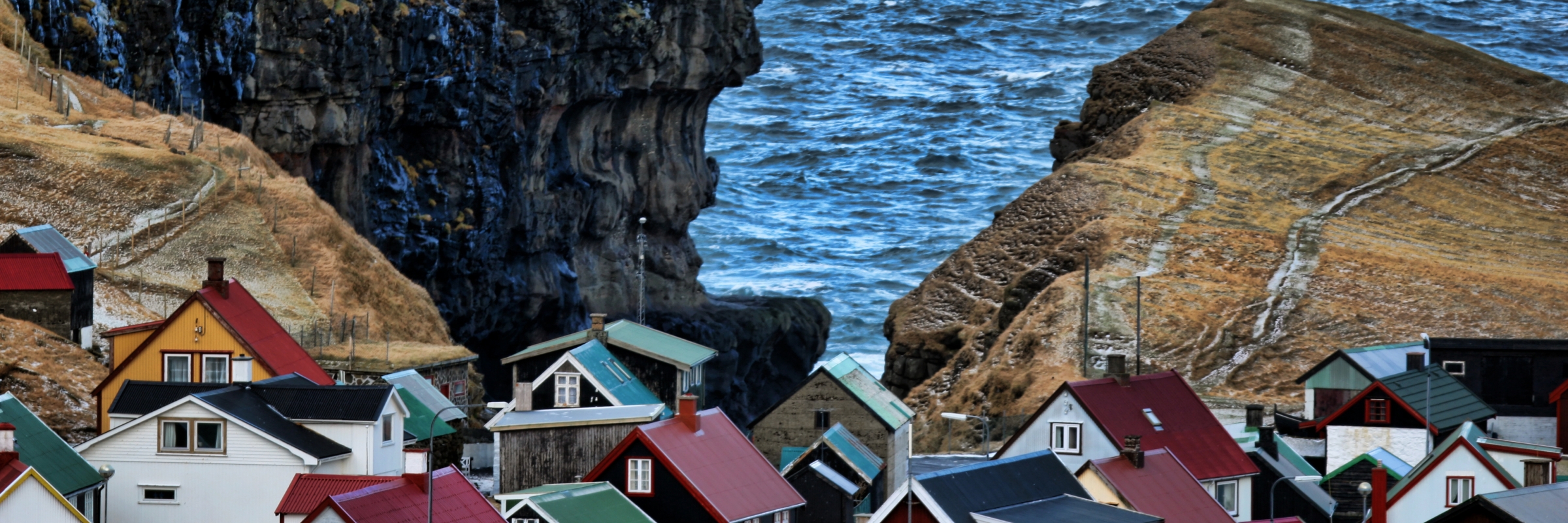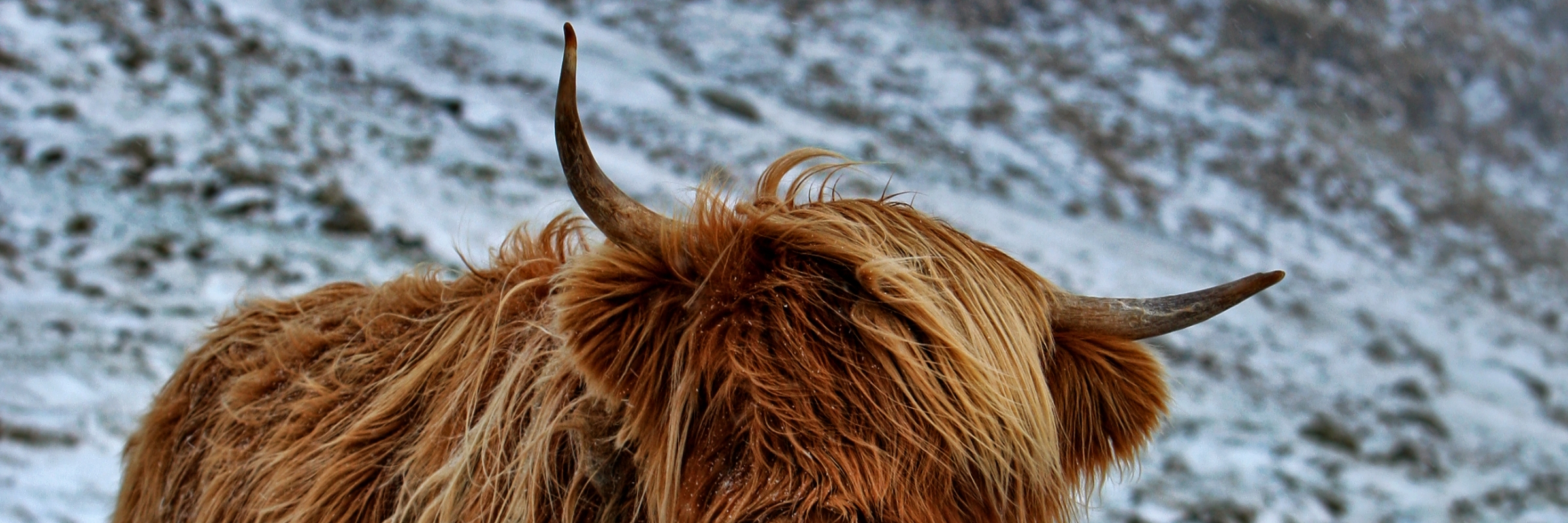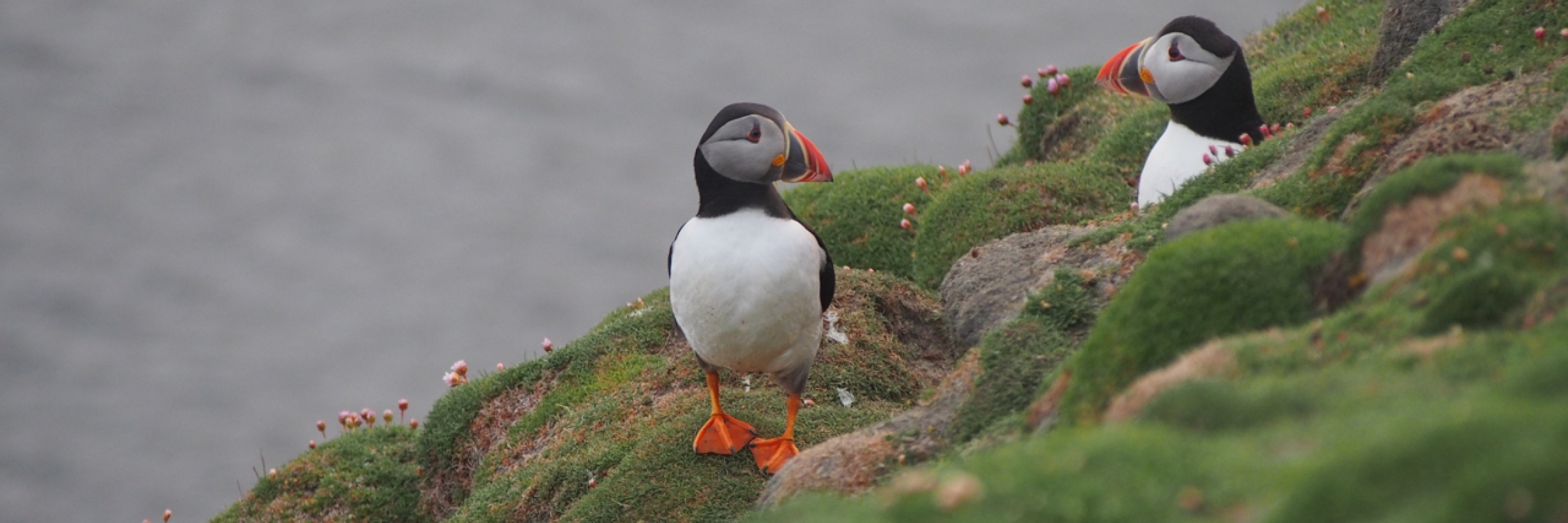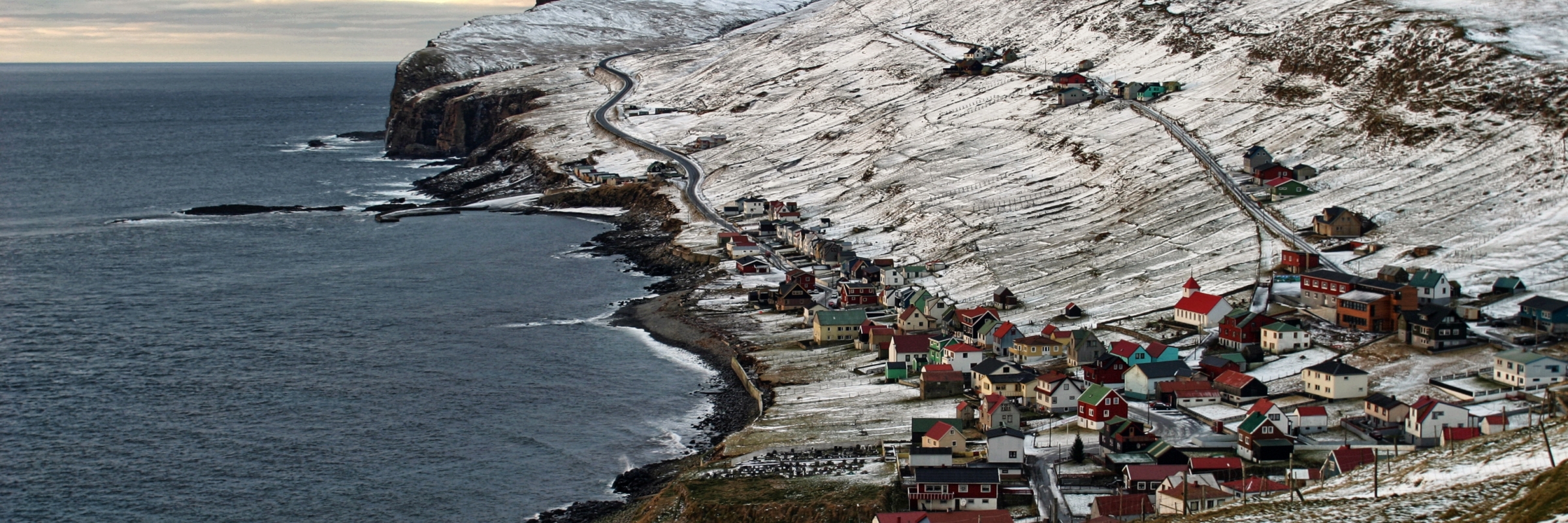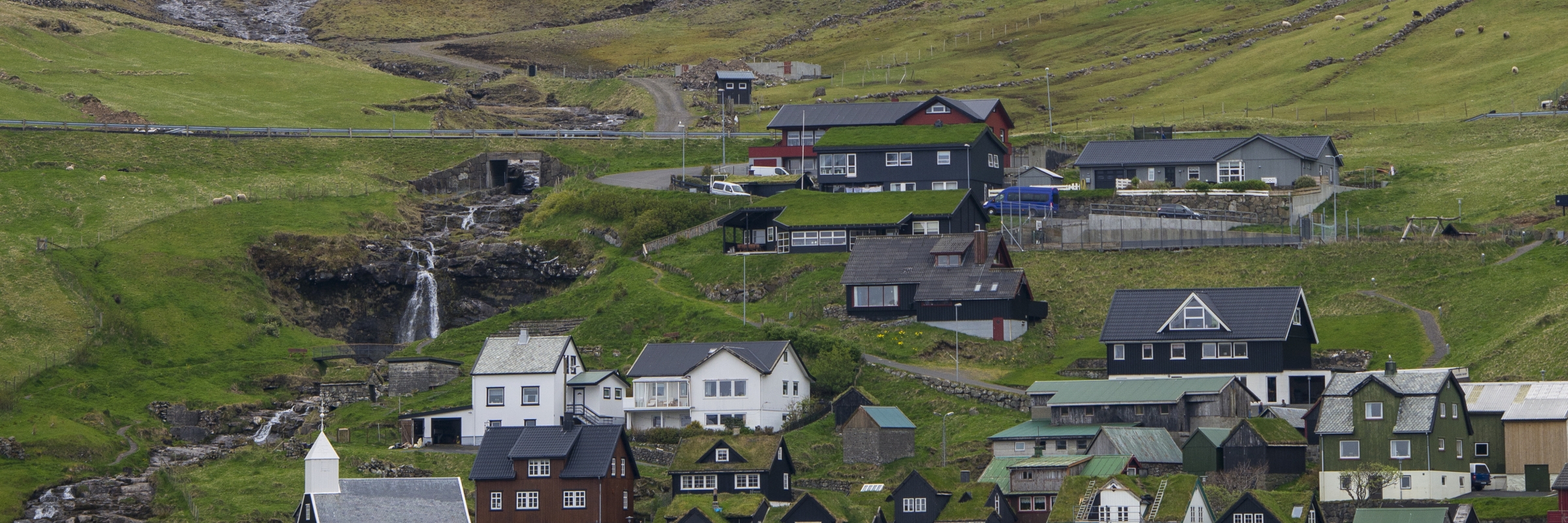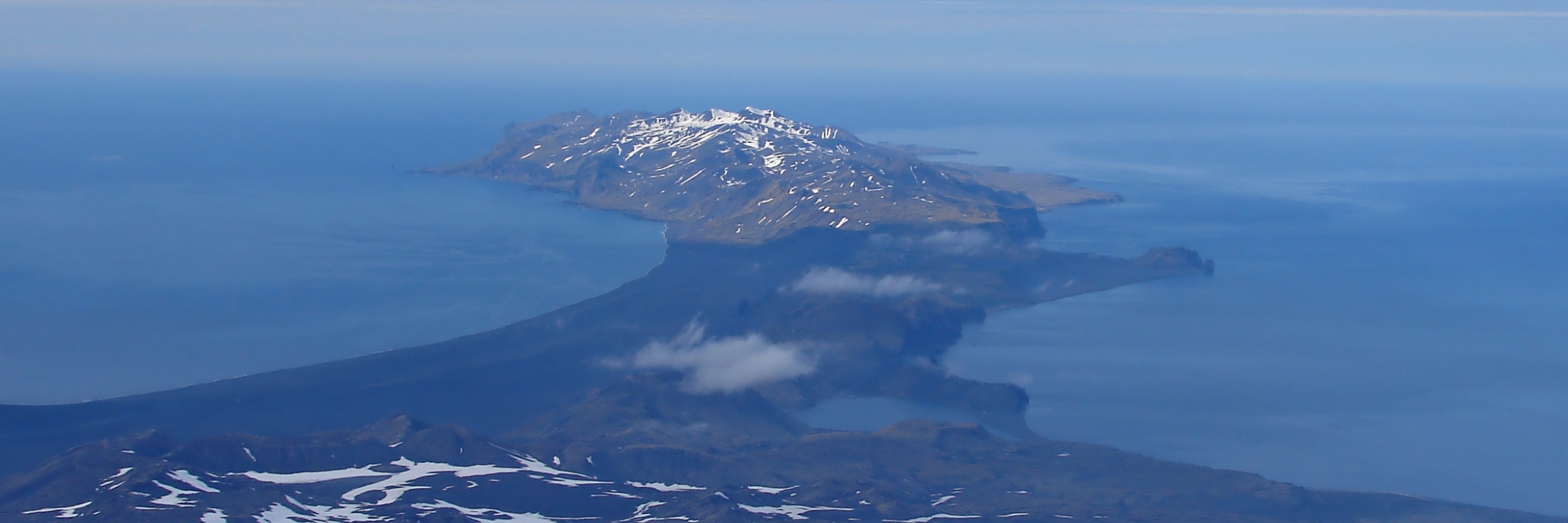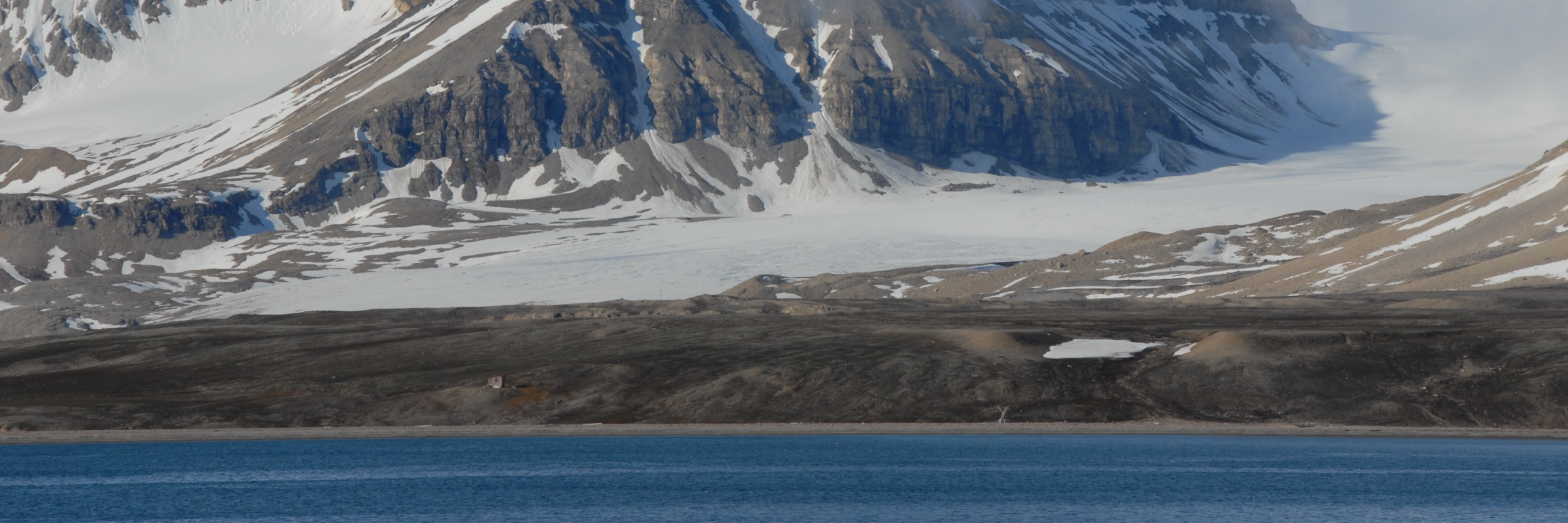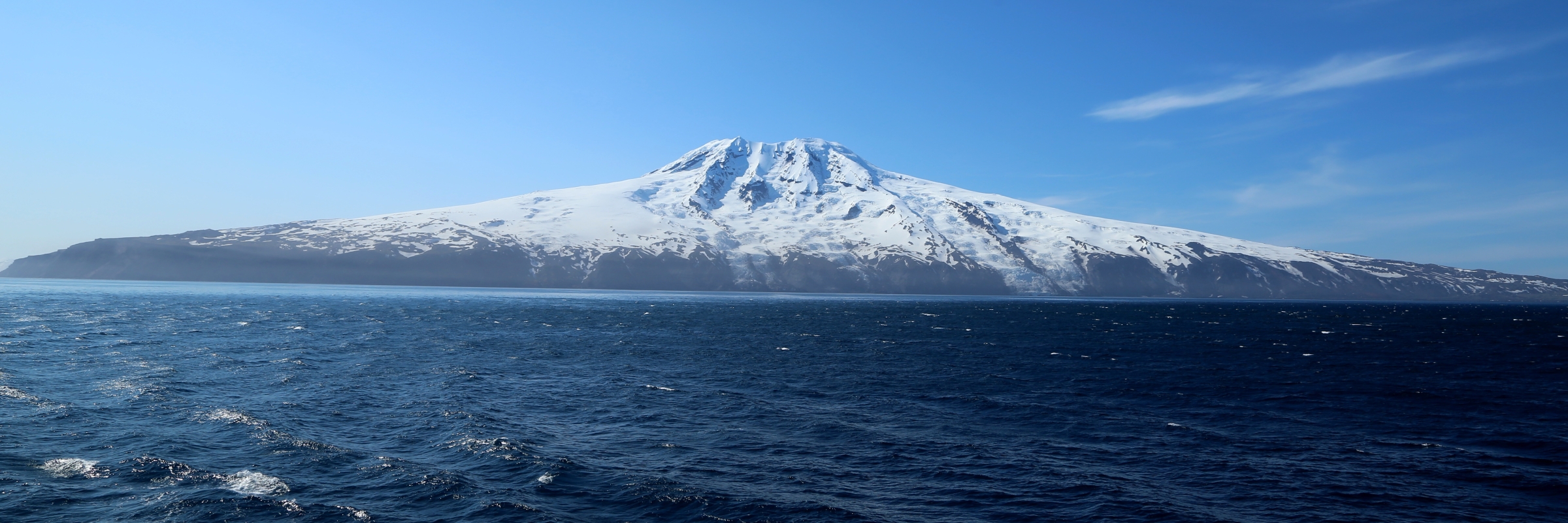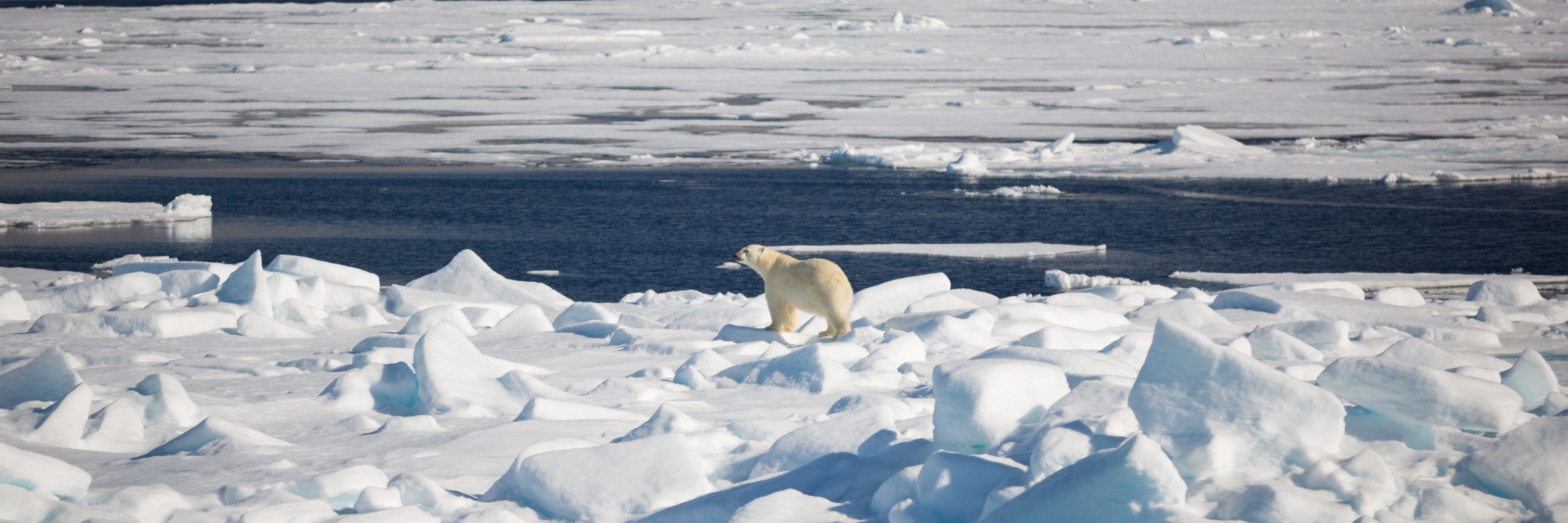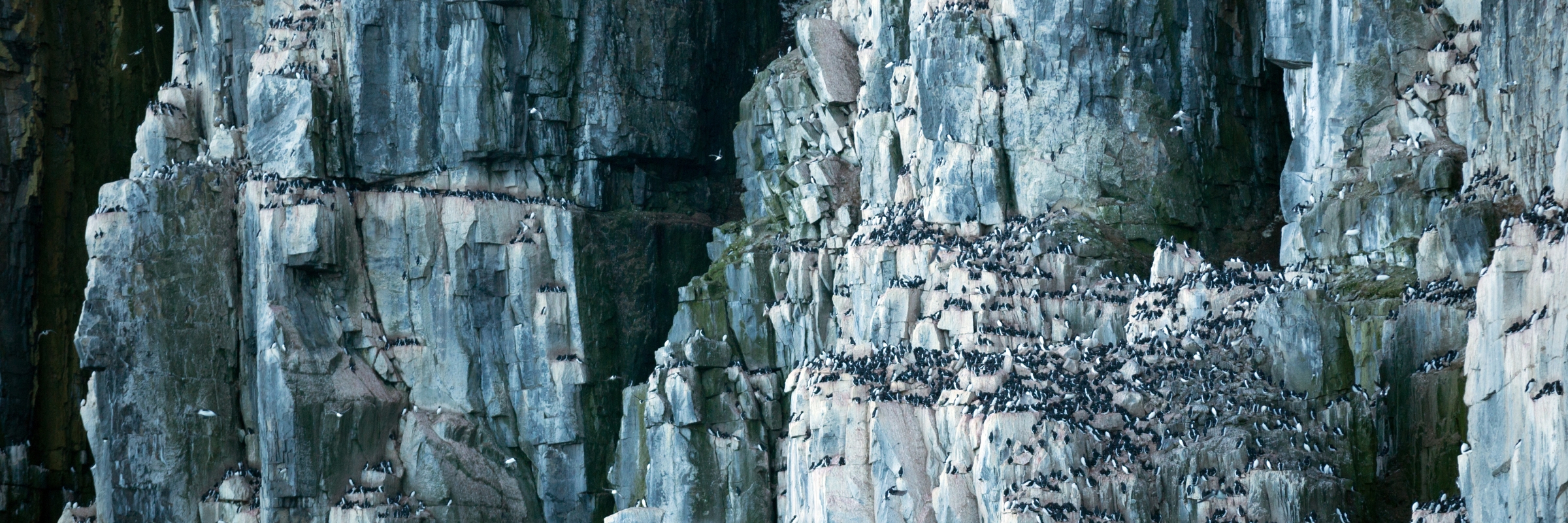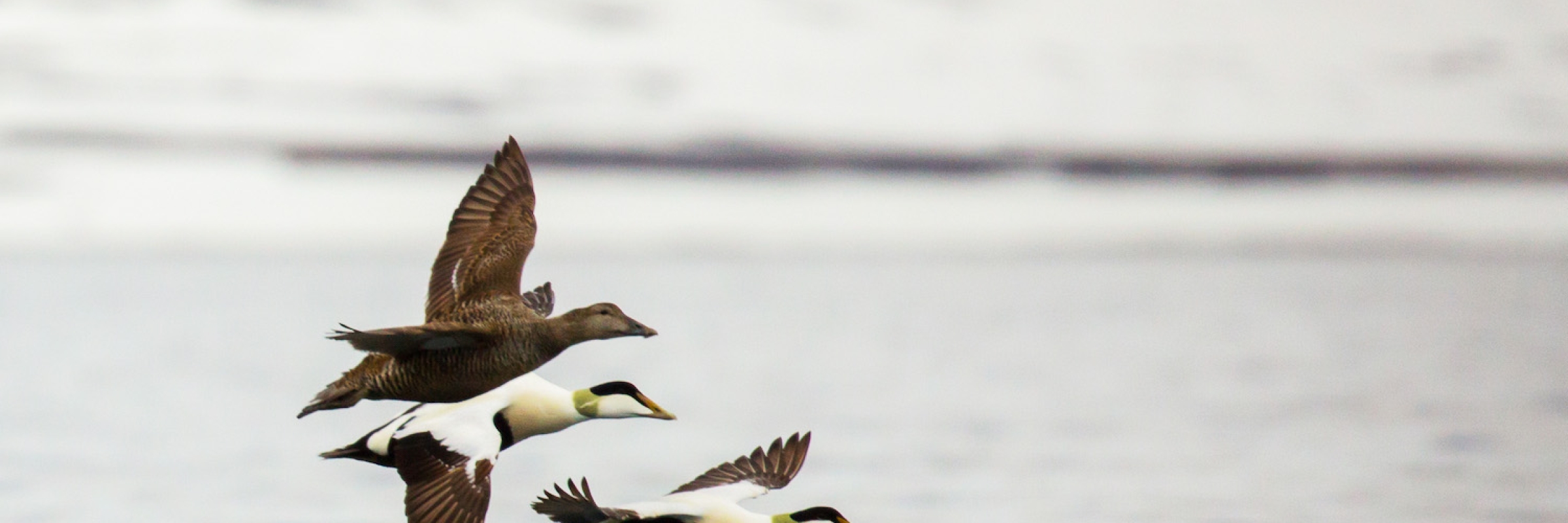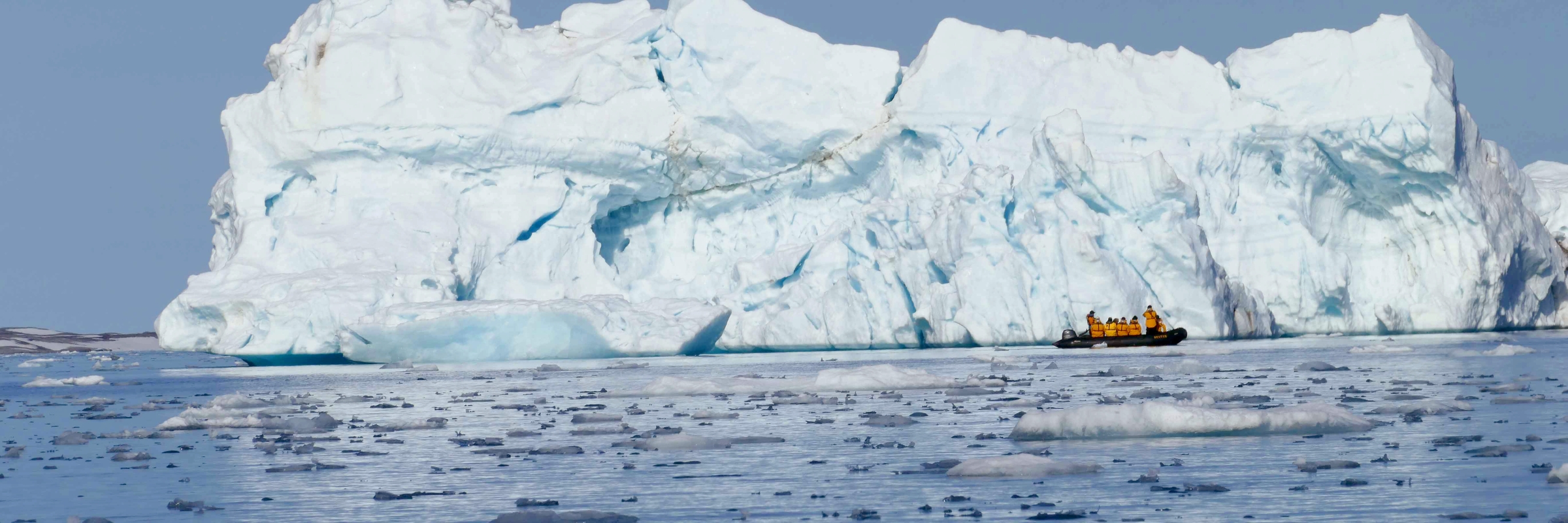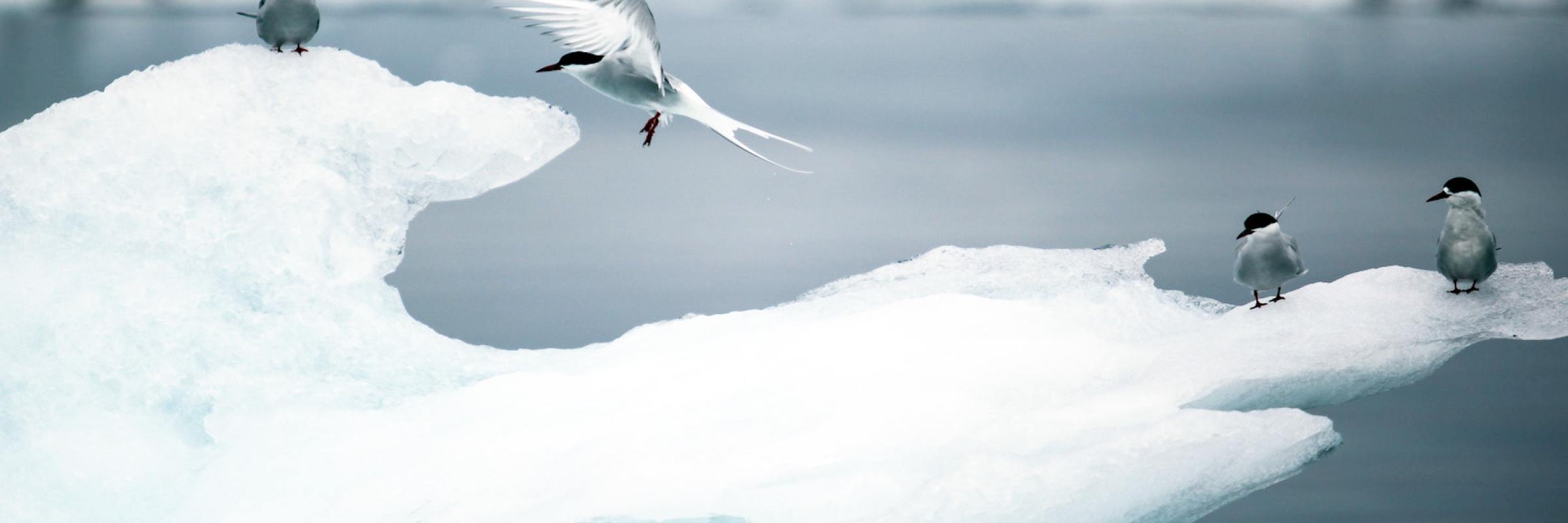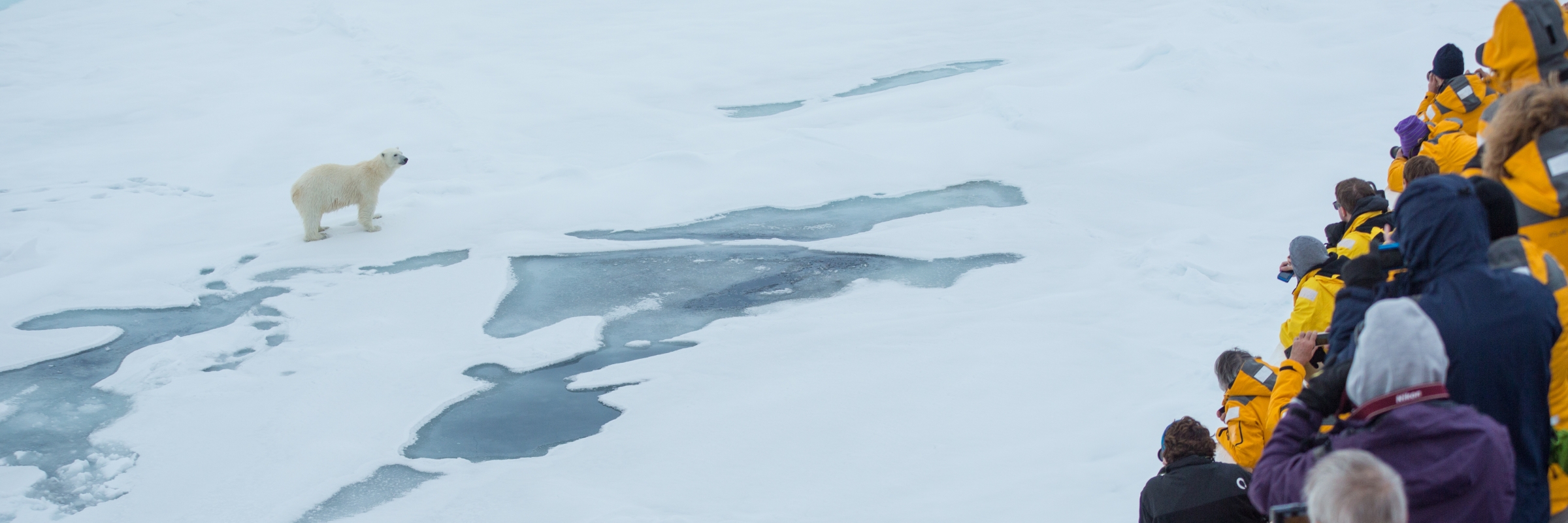Arrive any time on Day 1 and make your way to your included hotel. The gateway for your Arctic adventure, the Scottish city of Aberdeen has many monikers, but its most famous is Granite City, as it was once the granite capital of the world. Wandering the streets, you’ll soon see why, as the Victorian buildings sparkle in the sun. A bustling cultural hub, Aberdeen also offers a range of museums, galleries, theaters, shops, cafés and restaurants to explore.
Arctic Saga: Exploring Spitsbergen via the Faroes and Jan Mayen
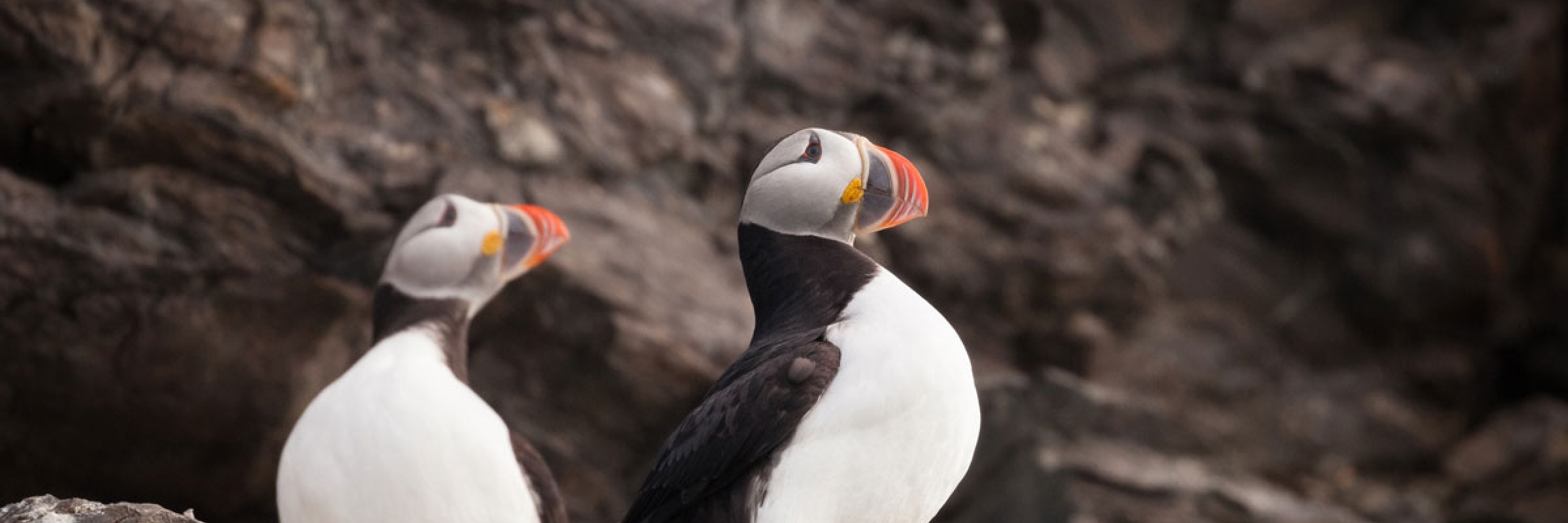
Ideal for first-time guests to the polar regions, Arctic Saga: Exploring Spitsbergen via the Faroes and Jan Mayen allows you to venture to some of the most remote islands on Earth, observe fascinating history and culture, and experience the dreamlike wonder of the midnight sun. Sailing across the North Atlantic, you will be immersed in the Arctic’s rugged beauty, highlighted by visits to the awe-inspiring and unspoiled destinations of Fair Isle, the Faroe Islands, Jan Mayen and Spitsbergen.
Prepare to be amazed by an environment different from anything you’ve ever witnessed, featuring immense fjords, towering glaciers, soaring sea stacks and coastal cliffs teeming with seabirds by the thousands. Observe reindeer, seals and whales in their natural habitat under a sunlit sky in the middle of the night. Guided by the most knowledgeable and passionate team in the industry, go where few others have gone, and return forever changed by the rich history, distinct culture and unforgettable backdrop of the Arctic.
- Follow in the footsteps of the Norsemen on Fair Isle and the Vikings in the Faroe Islands
- Explore the volcanic and glacier covered Jan Mayen island, in the heart of the North Atlantic Ocean
- Encounter iconic arctic wildlife, such as puffins, reindeer, whales and seabirds
- Cruise in a Zodiac to explore diverse landscapes and wildlife
行程
Day 1 — Arrive in Aberdeen, United Kingdom
Day 2 — Embarkation Day
Today you will have some free time before being transferred to the port to board your ship. As you set sail this afternoon, you’ll want to be out on deck, camera in hand—the area’s coastal waters offer excellent possibilities for spotting bottlenose and white-beaked dolphins, harbor porpoises and minke whales.
Day 3 — Exploring Fair Isle
The U.K.’s most remote inhabited island, the extraordinary Fair Isle is located halfway between the Shetland and Orkney Islands. Boasting a rugged beauty, Fair Isle’s landscape is diverse, with fields and moors dominated by seaside cliffs and an astounding number of sea stacks, natural arches and caves.
Despite its small size, the island offers activities for history, nature and photography buffs alike. Visit the museum to immerse yourself in local artifacts, photos, knitwear and other historic memorabilia. Don’t forget to snap a shot of the circa 1935 classic red phone booth by the post office!
In terms of wildlife, orcas are native to the waters around Fair Isle, and they sometimes come close in pursuit of seals. But the island is best known for its coastal cliffs teeming with seabirds in spring and summer. The star attraction is the Atlantic puffin, a clown-like bird that clings to the steep slopes. Photographers will surely want to capture pictures of their bemused expressions, and Fair Isle’s easily accessible grassy banks make it one of the best places in the Shetlands to observe these colorful creatures. Northern fulmars, kittiwakes, storm petrels, razorbills and guillemots may be spotted soaring over the open waters. Visitors to this community of crofters, artisans and artists may be able to pick up a traditional Fair Isle sweater to keep warm during the rest of your Arctic voyage.
Days 4 and 5 — Exploring the Faroe Islands
Known for its beautiful, unspoiled landscape, with verdant pastures giving way to rugged, steep cliffs, the Faroe Islands have a storied past, though the details of the archipelago’s early history remain mysterious. The first settlers may have been seventh-century Irish monks seeking solitude on these islands far removed from any continent. Their isolation ended in 800 AD, with the arrival of Norse farmers, and Norwegian colonization continued throughout the Viking Age. Today, many of the inhabitants of the Faroe Islands, now a self-governing country within the Kingdom of Denmark, are descendants of Norwegian Vikings, and speak Faroese, a descendant language of Old Norse.
We will have two days to explore this seldom-visited archipelago made up of 18 rugged islands located about halfway between Scotland and Iceland. The mighty North Atlantic is omnipresent wherever we go with no place on the Faroe Islands farther than 3 miles (5 km) from its shores. The sea has always dominated life on the Faroes—throughout history as much as today: rich fisheries, magnificent ocean views and thriving sea bird colonies make up this rare Nordic jewel—often referred to as Europe’s best kept secret.
We will spend a day exploring the outer islands of the archipelago, separated by narrow sounds and fjords, and delight in their surreal landscapes, dramatic cliffs, and rock formations. You’ll see green valleys engulfed by steep mountains, protecting picturesque villages with colorful turf-topped homes. Wind, weather and sea conditions will influence and shape our activity options, but we will of course always keep our eyes out for marine and bird life, especially the iconic Atlantic puffin.
Our second day in the Faroes will be dedicated to the capital city of Tórshavn, where the Vikings established their government in 825 AD. One of the world’s smallest capitals, the picturesque Tórshavn has a relaxed vibe and a number of historical and cultural sites. Meander the maze of narrow laneways of the Old Town, admiring the quaint wooden houses with traditional sod roofs and white paned windows. If you’re looking for more action, a hike to historic Kirkjubøur not only unlocks some of the country’s best medieval history but also rewards with sweeping views over the southern islands of Koltur, Hestur & Sandur. Or perhaps you prefer to wander the charming harbor, filled with cafés, pubs and old warehouses, and simply gaze out at the sea while sipping a latte.
Days 6 and 7 — At Sea
Say goodbye to the Faroes as we cruise toward the world’s most northerly volcanic island, Jan Mayen. There are several activities to keep you engaged while at sea. Learn to identify seabirds gliding alongside your ship, attend dynamic presentations by your Expedition Team, relax in our polar library or simply spend some time on deck, admiring the ocean views. With your binoculars and camera at the ready, keep your eyes peeled for the blow of a humpback, blue or fin whale. Encounters with minke whales or orcas are also possible, since their curiosity can bring them near the ship. If you’re lucky, you may even see harp seals.
Days 8 and 9 — Exploring Jan Mayen
North of the Arctic Circle, about 280 miles (450 km) east of Greenland and 340 miles (550 km) north of Iceland, the mysterious Jan Mayen rises from the depths of the North Atlantic Ocean. Often shrouded in thick fog, the small mountainous island was declared a nature reserve in 2010 and is rarely visited, save for the 18 rotating personnel of the Norwegian military and Norwegian Meteorological Institute, who are the only inhabitants.
Landing here will be dictated by the weather and sea. If conditions allow, as we approach, keep watch on deck as the spoon-shaped island’s highest summit emerges. At 7,470 feet (2,277 meters) high, the breathtaking Beerenberg volcano features a symmetrical cone shape and impressive glaciers that spill into the sea. During the summer months, the island’s lower landscape is covered with grass, moss and a smattering of hardy flowers that add a burst of color to the otherwise barren black lava terrain. One site we hope to visit is Olonkinbyen and the surrounding area. Named after Russian-Norwegian polar explorer Gennady Olonkin, it’s the island’s only settlement and the location of the meteorological station, where you may have the chance to learn about polar research while seeing how weather is monitored at the top of the world. Another option might be the black sand beach at Kvalrossbukta, where the remnants of a 17th-century Dutch whaling station and a large fulmar colony can be found. In 1632, two Basque ships landed at the small bay and plundered the station. A Dutch party was sent here the following year to protect the land stations during winter, but all seven men perished from scurvy. Whaling in the area came to an end about 20 years later.
If conditions permit, we may view the volcano and the stratified cliffs of the spectacular north coast as we Zodiac cruise around the island, searching for wildlife. Designated an Important Bird Area by BirdLife International for the large numbers of breeding seabirds, Jan Mayen supports colonies of northern fulmars, little auks, glaucous gulls, kittiwakes, and black and Brünnich’s guillemots (thick-billed murres). And if we are fortunate, you might see “sea parrots,” the Atlantic puffin again. The waters here are rich feeding grounds for marine life, so keep a lookout for minke, fin, blue or humpback whales.
Day 10 — At Sea
As we sail farther north, spend some time with your shipmates in the lounge, swapping stories and photos, or pause for a moment on the bridge, joining in as your Expedition Team looks out for whales, seals and a variety of seabirds.
Days 11 to 13 — Exploring Spitsbergen, Svalbard
Rugged, wild and situated entirely within the Arctic Circle, the largest island of the Svalbard archipelago is unforgettable. From immense glaciers to lush tundra to polar deserts, the landscape here is as varied as the wildlife. As we explore the fjords of the southwestern corner of this magical island, it won’t take long for you to see firsthand why Spitsbergen is the “wildlife capital of the Arctic.” Some areas we hope to visit include Hornsund and Bellsund fjords and the Lilliehöök Glacier.
The possible landing sites at Hornsund, the island’s most southerly fjord, have rich histories. You may visit Isbjornhamna, a bay at the entrance of the fjord, where we hope to explore colonies of delightful little auks. You may also spot Svalbard reindeer and hike to a viewpoint for views of calving glaciers.
A 12-mile (20 km) long sound, Bellsund lured miners a century ago to its natural resources. Today, visitors come to Bourbonhamna and Calypsobyen to see historic mining and trapper sites and marvel at the magnificent vistas. It may also be possible to hike along the colorful tundra, dotted with flowers bursting for a taste of sunshine, and discover old whale bones.
Day 14 — Disembark in Longyearbyen and Fly to Oslo
The time has come to say farewell to your newfound friends and Expedition Team. After disembarking, spend the day exploring the frontier-style settlement of Longyearbyen or catch your homeward flights.
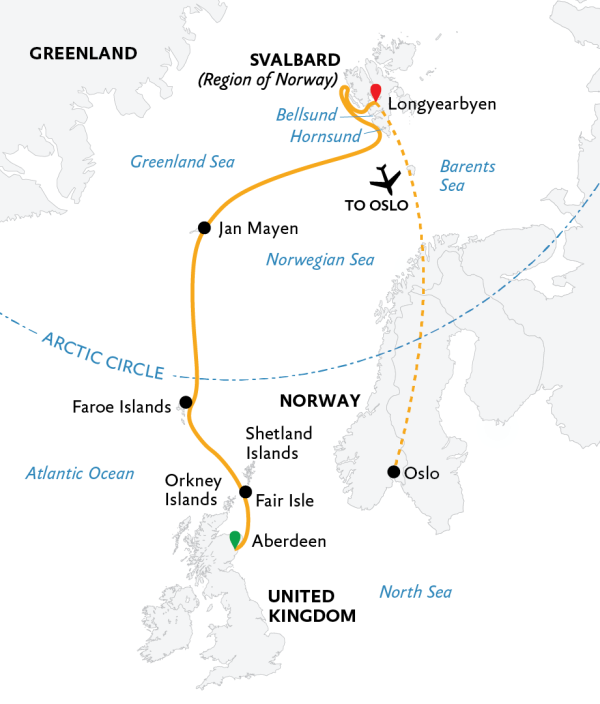
Day 1 — Arrive in Aberdeen, United Kingdom
Arrive any time on Day 1 and make your way to your included hotel. The gateway for your Arctic adventure, the Scottish city of Aberdeen has many monikers, but its most famous is Granite City, as it was once the granite capital of the world. Wandering the streets, you’ll soon see why, as the Victorian buildings sparkle in the sun. A bustling cultural hub, Aberdeen also offers a range of museums, galleries, theaters, shops, cafés and restaurants to explore.
Day 2 — Embarkation Day
Today you will have some free time before being transferred to the port to board your ship. As you set sail this afternoon, you’ll want to be out on deck, camera in hand—the area’s coastal waters offer excellent possibilities for spotting bottlenose and white-beaked dolphins, harbor porpoises and minke whales.
Day 3 — Exploring Fair Isle
The U.K.’s most remote inhabited island, the extraordinary Fair Isle is located halfway between the Shetland
and Orkney Islands. Boasting a rugged beauty, Fair Isle’s landscape is diverse, with fields and moors dominated by seaside cliffs and an astounding number of sea stacks, natural arches and caves. Despite its small size, the island offers activities for history, nature and photography buffs alike. Visit the museum to immerse yourself in local
artifacts, photos, knitwear and other historic memorabilia. Don’t forget to snap a shot of the circa 1935 classic
red phone booth by the post office!
In terms of wildlife, orcas are native to the waters around Fair Isle, and they sometimes come close in pursuit of seals. But the island is best known for its coastal cliffs teeming with seabirds in spring and summer. The star attraction is the Atlantic puffin, a clown-like bird that burrows in nests in the grassy flat tops of the island’s cliffs. Photographers will surely want to capture pictures of their bemused expressions, and Fair Isle’s easily accessible grassy banks make it one of the best places in the Shetlands (if not the entire Scottish Isles!) to observe these colorful creatures. Northern fulmars, kittiwakes, storm petrels, razorbills and guillemots may be spotted soaring over the open waters.
Visitors to this community of crofters, artisans and artists may be able to pick up a traditional Fair Isle sweater to keep warm during the rest of your Arctic voyage.
Days 4 and 5 — Exploring the Faroe Islands
Known for its beautiful, unspoiled landscape, with verdant pastures giving way to rugged, steep cliffs, the Faroe
Islands have a storied past, though the details of the archipelago’s early history remain mysterious. The first settlers may have been seventh-century Irish monks seeking solitude on these islands far removed from any continent. Their isolation ended in 800 AD, with the arrival of Norse farmers, and Norwegian colonization continued throughout the Viking Age. Today, many of the inhabitants of the Faroe Islands, now a self-governing country within the Kingdom of Denmark, are descendants of Norwegian Vikings, and speak Faroese, a descendant language of Old Norse.
We will have two days to explore this seldom-visited archipelago made up of 18 rugged islands located about halfwaybetween Scotland and Iceland. The mighty North Atlantic is omnipresent wherever we go with no place on the Faroe Islands farther than 3 miles (5 km) from its shores. The sea has always dominated life on the Faroes—throughout history as much as today: rich fisheries, magnificent ocean views and thriving sea bird colonies make up this rare Nordic jewel— often referred to as Europe’s best kept secret.
We will spend a day exploring the outer islands of the archipelago, separated by narrow sounds and fjords, and delight in their surreal landscapes, dramatic cliffs, and rock formations. You’ll see green valleys engulfed by steep mountains, protecting picturesque villages with colorful turf-topped homes. Wind, weather and sea conditions will influence and shape our activity options, but we will of course always keep our eyes out for marine and bird life, especially the iconic Atlantic puffin.
Our second day in the Faroes will be dedicated to the capital city of Tórshavn, where the Vikings established their government in 825 AD. One of the world’s smallest capitals, the picturesque Tórshavn has a relaxed vibe and a number of historical and cultural sites. Meander the maze of narrow laneways of the Old Town, admiring the quaint wooden houses with traditional sod roofs and white paned windows. If you’re looking for more action, a hike to historic Kirkjubøur not only unlocks some of the country’s best medieval history but also rewards with sweeping views over the southern islands of Koltur, Hestur & Sandur. Or perhaps you’ll prefer to wander the charming harbor, filled with cafés, pubs and old warehouses, and simply gaze out at the sea while sipping a latte.
Days 6 and 7 — Cruising
Say goodbye to the Faroes as we cruise toward the world’s most northerly volcanic island, Jan Mayen. There are several activities to keep you engaged while at sea. Learn to identify seabirds gliding alongside your ship, attend dynamic presentations by your Expedition Team, relax in our polar library or simply spend some time on deck, admiring the ocean views. With your binoculars and camera at the ready, keep your eyes peeled for the blow of a humpback, blue or fin whale. Encounters with minke whales or orcas are also possible, since their curiosity can bring them near the ship. If you’re lucky, you may even see harp seals.
Days 8 and 9 — Exploring Jan Mayen
North of the Arctic Circle, about 280 miles (450 km) east of Greenland and 340 miles (550 km) north of Iceland, the mysterious Jan Mayen rises from the depths of the North Atlantic Ocean. Often shrouded in thick fog, the small mountainous island was declared a nature reserve in 2010 and is rarely visited, save for the 18 rotating personnel of the Norwegian military and Norwegian Meteorological Institute, who are the only year-long inhabitants, save for some additional personnel during the summer.
Landing here will be dictated by the weather and sea. If conditions allow, as we approach, keep watch on deck as the spoon-shaped island’s highest summit emerges. At 7,470 feet (2,277 meters) high, the breathtaking Beerenberg volcano features a symmetrical cone shape and impressive glaciers that spill into the sea. During the summer months, the island’s lower landscape is covered with grass, moss and a smattering of hardy flowers that add a burst of color to the otherwise barren black lava terrain. One site we hope to visit is Olonkinbyen and the surrounding area. Named after Russian-Norwegian polar explorer Gennady Olonkin, it’s the island’s only settlement and the location of the meteorological station, where you may have the chance to learn about polar research while seeing how weather is monitored at the top of the world.
Another option might be the black sand beach at Kvalrossbukta, where the remnants of a 17th-century Dutch whaling station and a large northern fulmar colony can be found. In 1632, two Basque ships landed at the small bay and plundered the station. A Dutch party was sent here the following year to protect the land stations during winter, but all seven men perished from scurvy. Whaling in the area came to an end about 20 years later.
If conditions permit, we may view the volcano and the stratified cliffs of the spectacular north coast as we Zodiac cruise around the island, searching for wildlife. Designated an Important Bird Area by BirdLife International for the large numbers of breeding seabirds, Jan Mayen supports colonies of northern fulmars, little auks, glaucous gulls, kittiwakes, and black and Brünnich’s guillemots (thick-billed murres). And if we are fortunate, you might see “sea parrots,” the Atlantic puffin again. The waters here are rich feeding grounds for marine life, so keep a lookout for minke, fin, blue or humpback whales.
Day 10 — At Sea
As we sail farther north, spend some time with your shipmates in the lounge, swapping stories and photos, or pause for a moment on the bridge, joining in as your Expedition Team looks out for whales, seals and a variety of seabirds.
Days 11 to 13 — Exploring Spitsbergen, Svalbard
Rugged, wild and situated entirely within the Arctic Circle, the largest island of the Svalbard archipelago is unforgettable. From immense glaciers to lush tundra to polar deserts, the landscape here is as varied as the wildlife.
As we explore the fjords of the southwestern corner of this magical island, it won’t take long for you to see firsthand why Spitsbergen is the “wildlife capital of the Arctic.” Some areas we hope to visit include Hornsund and Bellsund fjords and Hornbreen Glacier.
The possible landing sites at Hornsund, the island’s most southerly fjord, have rich histories. You may visit Isbjornhamna, a bay at the entrance of the fjord, where we hope to explore colonies of delightful little auks. You may also spot Svalbard reindeer and hike to a viewpoint for views of calving glaciers. A 12-mile (20 km) long sound, Bellsund lured miners a century ago to its natural resources. Today, visitors come to Bourbonhamna and Calypsobyen to see historic mining and trapper sites and marvel at the magnificent vistas. It may also be possible to hike along the colorful tundra, dotted with flowers bursting for a taste of sunshine, and discover old whale bones.
Day 14 — Disembark in Longyearbyen and Fly to Oslo
The time has come to say farewell to your newfound friends and Expedition Team. After disembarking, spend the day exploring the frontier-style settlement of Longyearbyen or catch your homeward flights.
